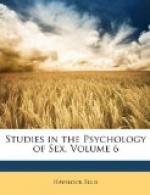Ellen Key in Ch. VI of her Century of the Child well summarizes the reasons against the practice of selecting for children books that are “suitable” for them, a practice which she considers one of the follies of modern education. The child should be free to read all great literature, and will himself instinctively put aside the things he is not yet ripe for. His cooler senses are undisturbed by scenes that his elders find too exciting, while even at a later stage it is not the nakedness of great literature, but much more the method of the modern novel, which is likely to stain the imagination, falsify reality and injure taste. It is concealment which misleads and coarsens, producing a state of mind in which even the Bible becomes a stimulus to the senses. The writings of the great masters yield the imaginative food which the child craves, and the erotic moment in them is too brief to be overheating. It is the more necessary, Ellen Key remarks, for children to be introduced to great literature, since they often have little opportunity to occupy themselves with it in later life. Many years earlier Ruskin, in Sesame and Lilies, had eloquently urged that even young girls should be allowed to range freely in libraries.
What has been said about literature applies equally to art. Art, as well as literature, and in the same indirect way, can be made a valuable aid in the task of sexual enlightenment and sexual hygiene. Modern art may, indeed, for the most part, be ignored from this point of view, but children cannot be too early familiarized with the representations of the nude in ancient sculpture and in the paintings of the old masters of the Italian school. In this way they may be immunized, as Enderlin expresses it, against those representations of the nude which make an appeal to the baser instincts. Early familiarity with nudity in art is at the same time an aid to the attainment of a proper attitude towards purity in nature. “He who has once learnt,” as Hoeller remarks, “to enjoy peacefully nakedness in art, will be able to look on nakedness in nature as on a work of art.”




